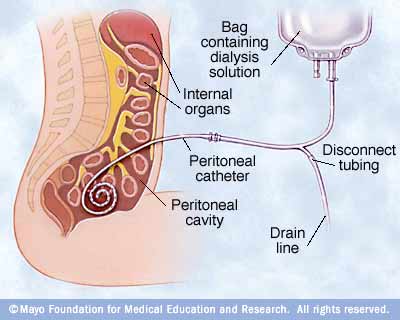
Source: ealthcareadministration1.com
What is Peritoneal Dialysis?
Peritoneal dialysis (PD) is a dialysis treatment that is used as an alternative to haemodialysis (HD) for patients with severe kidney disease. In peritoneal dialysis, the patient’s peritoneum which is located in the abdomen acts as a membrane which filters out fluids and other dissolved substances from the blood. The waste products from the patient’s body are flushed out either every night while the patient sleeps (automatic peritoneal dialysis) or via regular exchanges throughout the day (continuous ambulatory peritoneal dialysis).
PD is commonly used in many countries as an alternative to haemodialysis. The primary advantage of PD is that patients do not need to visit a medical facility regularly for their dialysis. The primary complication of PD is infection!
There are two types of peritoneal dialysis: 1) Continuous Ambulatory Peritoneal Dialysis and 2) Automated Peritoneal Dialysis.
i) Continuous Ambulatory Peritoneal Dialysis (CAPD)
With Continuous Ambulatory Peritoneal Dialysis (CAPD), patients will be required to be dialysed 3 – 5 times per day by themselves. Gravity will draw the dialysate in and out of the peritoneal cavity, through the connecting tubing and bags. CAPD requires the patient to connect tubing and a bag of sterile dialysate to the peritoneal catheter. The bag is elevated to shoulder level, allowing the solution to flow into the peritoneum. Waste products and excess fluid pass from the blood, through the patient’s peritoneal membrane (lining of the abdomen), which acts as a filter, and into the dialysate. Once this is completed, all fluid and waste from the patient’s peritoneal cavity are drained and exchanged with a fresh solution.
ii) Automated Peritoneal Dialysis (APD)
Automated peritoneal dialysis (APD) is performed by a machine, called a cycler, while the patient is asleep. Like CAPD, APD uses the patient’s peritoneal membrane as a filter to draw waste and excess fluid from the patient’s blood into a dialysate solution. The APD machine automatically controls the timing of exchanges, drains the used solution and fills the peritoneal cavity with new solution; based on the prescribed number of exchanges. For extra treatment, dialysis solution remains in the patient’s peritoneal cavity during the day. The peritoneal cavity of most adults can comfortably hold two-to-three liters of fluid.

Source: renalfellow.blogspot.com
Advantages and Disadvantages of Peritoneal Dialysis
While peritoneal dialysis serves a similar function to haemodialysis, there are certain advantages and disadvantages that differentiate peritoneal dialysis from haemodialysis.
i) Advantages
- Fit the dialysis treatment around the patient’s lifestyle;
- Patient independence;
- Fewer visits to the dialysis unit (usually once a month);
- Dialysis done during sleep time for some patients;
- Continuous therapy is gentler and more similar to natural kidney function;
- PD is portable and flexible;
- Less fluid and diet restrictions;
- No needles needed; and
- Better blood pressure control.
ii) Disadvantages
- Patients need to be well trained;
- Permanent catheter access required;
- Some risk of infection;
- Some patients may show a slightly larger waistline (due to carrying fluid); and
- Storage space required in the patient’s home.
In addition to the advantages and disadvantages listed above, most studies showed that the relative risk of death in patients on in-center HD versus PD changes over time, with a lower risk on PD, especially in the first 3 months of dialysis. The survival advantage of PD continues for 1.5-2 years but, over time, the risk of death with PD equals or becomes greater than with in-center HD, depending on patients’ factors. Thus, PD survival is best at the start of dialysis.
A study of the advantages and disadvantages of peritoneal dialysis revealed that peritoneal dialysis can be a good alternative for patients who require dialysis but wish to maintain their activities of daily living, including the ability to go to work on a fulltime basis. This, in turn, increases the productivity of dialysis patients who are able to contribute to the society and to continue supporting their own families.
Mr Mark Cheong is a pharmacist currently working in Kuala Lumpur. He is also pursuing his doctorate in public health. Find out more about him at The Team page.
[This article belongs to The Malaysian Medical Gazette. Any republication (online or offline) without written permission from The Malaysian Medical Gazette is prohibited.]
References:
- www.mayoclinic.com/health/peritoneal-dialysis/MY00282
- www.kidney.org/atoz/content/peritoneal.cfm
- 20th report of the Malaysian Dialysis and Transplant Registry 2012
